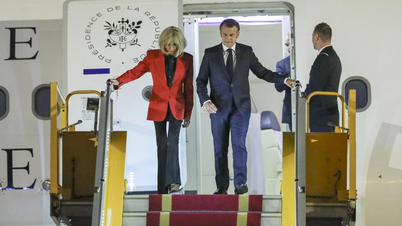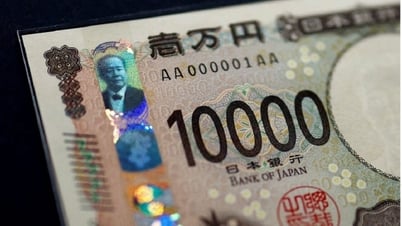The greenback continued to weaken in Monday's trading session, as the Taiwanese dollar's (TWD) meteoric rise spread to other markets, raising expectations that some Asian countries may be preparing to adjust their exchange rates in order to seek trade concessions from the United States.
Specifically, the TWD increased by more than 3% to 29.618 per USD, following a record increase of 4.5% in Friday's session, bringing the currency to its highest level in the past two years.
Although Taiwan's central bank denied there was pressure from the White House to appreciate the currency as part of a trade deal, markets still sensed a change in policy direction.
Similarly, China's yuan (CNY) also rose to its highest in nearly six months, trading at 7.1980 CNY/USD, amid bets that Beijing could allow the yuan to strengthen as part of Sino-US trade talks, although progress remains far from certain.
China's Commerce Ministry said Beijing is evaluating a proposal from Washington to resume talks over the 145% tariffs imposed by the Trump administration, but the gap between the two sides remains wide.
In an interview broadcast on Sunday, US President Donald Trump stressed that he believes China wants to reach a deal, but did not offer specific details or a timeline.
Mr. Trump also said he would not seek to remove Federal Reserve Chairman Jerome Powell, but continued to call for lower interest rates and called Mr. Powell a "tough guy."
The Fed meets on Wednesday and is expected to keep interest rates on hold following a strong March jobs report.
"The recent jobs report makes it almost certain that the Fed will keep interest rates unchanged this week and the chances of them cutting rates in June are now higher," said Michael Feroli, chief US economist at JPMorgan.
“In a context of heightened uncertainty, with symmetric risks around the dual objectives, the Fed will prefer to remain patient until the outlook is clearer,” he added.
The market is now pricing in a 37% chance of a rate cut in June, down from 64% a month ago. Goldman Sachs and Barclays have both moved their cut forecasts to July.
It is worth noting, however, that the greenback received only mild support from the jobs data and is struggling to sustain gains, partly due to low liquidity in Asia due to holidays in Japan and China.
Against the Japanese yen, the USD fell 0.45% to 144.31 JPY/USD, below the recent peak of 145.91 on Friday.
Japanese Finance Minister Katsunobu Kato has backed away from comments that appeared to suggest Japan might threaten to sell some of its Treasury bonds as part of trade talks with the White House, which are expected to continue this week.
The abrupt change in US policy and pressure on the Fed's independence have undermined investor confidence in the US dollar, which is still evident in its current trading position.
Many investors continue to bet on weaker greenbacks, with speculative short positions rising in recent weeks, leaving the market vulnerable to any dollar-supportive news.
The next test for the greenback is the ISM services PMI due later on Monday, with the risk of a weak reading stoking fears of a recession.
For the pound, the focus this week is on Thursday's Bank of England (BoE) meeting, which is expected to cut interest rates by a further 25 basis points to 4.25% and could signal faster easing in the near future.
"The reaction of the UK government bond market and the pound will depend on the policy guidance and whether the BoE leaves the door open to further rate cuts at the June meeting, as well as whether the statement indicates a desire to reduce rates to 3.50% by the end of the year," said Chris Weston, Head of Research at Pepperstone.
The pound rose 0.11% to $1.3286 this morning, while the euro rose 0.29% to $1.1330, moving away from last week's low of $1.1266.
The central banks of Norway and Sweden will also meet this week and are expected to keep interest rates unchanged.
In Australia, the AUD held firm after Saturday's election, when Labor leader Anthony Albanese won a historic second term as Prime Minister .
The AUD rose 0.44% to $0.6462 this morning, after hitting a five-month high as US jobs data boosted global risk appetite.
The New Zealand dollar rose 0.39% to $0.5971.
Source: https://thoibaonganhang.vn/sang-55-ty-gia-trung-tam-giam-12-dong-163679.html




![[Photo] Funeral of former President Tran Duc Luong in Quang Ngai](https://vphoto.vietnam.vn/thumb/1200x675/vietnam/resource/IMAGE/2025/5/25/ccf19a3d8ea7450bb9afe81731b80995)


![[PHOTO] Hanoi fences off demolition of "Shark Jaws" building](https://vphoto.vietnam.vn/thumb/1200x675/vietnam/resource/IMAGE/2025/5/25/1b42fe53b9574eb88f9eafd9642b5b45)
![[Photo] French President Emmanuel Macron and his wife begin state visit to Vietnam](https://vphoto.vietnam.vn/thumb/1200x675/vietnam/resource/IMAGE/2025/5/25/03b59c7613144a35ba0f241ded642a59)
![[Photo] Ea Yieng commune settlement project abandoned](https://vphoto.vietnam.vn/thumb/1200x675/vietnam/resource/IMAGE/2025/5/25/57a8177361c24ee9885b5de1b9990b0e)



















































































Comment (0)